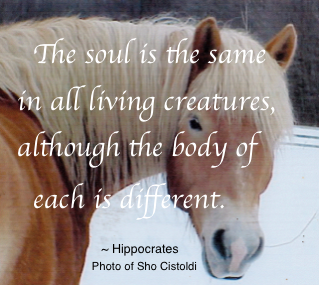~ A 15-Second Animal Communication Technique to Shape Behavior and Send Love ~
As much as we love our animals, as devoted as we may be to them, we have also most likely experienced times when we are frustrated, worried about or exasperated by their behavior, and want it to stop or be modified. Perhaps our horse freaks out getting into a trailer and we want them to go in without stress or fear. Maybe our cat won’t come in at dusk when called and we are concerned for their safety from predators; they wake us up at 4 am; or don’t use the litter box. Perhaps our dog barks and lunges at other dogs on walks, eats garbage, or won’t come when called.
The technique presented in this article is not in any way meant to be used in lieu of working with professional horse trainers, dog trainers, behaviorists or animal communicators. It can, however, powerfully enhance and reinforce such training and communication.
It can be used in conjunction with our work with trainers as a supplemental tool to change or reinforce behavior. It can be used as an effective follow-up tool after an animal communication consultation to clearly, lovingly and strongly reinforce behavior changes that have been discussed in detail and agreed upon. And it can also be used as a stand alone tool or first step in attempts to modify behavior. It works similarly to any reinforcement training—using love as a “reward” and imagery to explain the “specific behavior requested.”
Though animals do understand our words (expressed verbally or telepathically), pictures and feelings are the heart of telepathy—the core universal language used by all animals. As almost any animal lover can tell you, animals are masters at reading energy. Sensing our feelings and thoughts is natural for them. We can’t “hide”our feelings by saying we are happy when we’re sad, or pretending all is well when we’re furious—not from an animal! If our words are not aligned with our feelings, our emotional truth, they will know, because with animals (and sensitive humans), feelings trump words. When we say one thing but mean another, or say one thing but act in a contrary manner, animals will not only be aware of the discrepancy, they will likely become confused. This is why it is critical that we make sure that our words are aligned with our feelings when communicating with them verbally or telepathically.
In my conversations with thousands of animals, it has become clear to me that animals are quite capable of learning our language. They most definitely understand our words as long as the words we express are in genuine alignment with our feelings and thoughts. They seem to understand, absorb and trust images and feelings much more than words alone, or words that are contrary to the feelings or behavior of the sender.
I’ve come to believe that animals learn our words in some part as a favor to us—wanting to both please us, as well as to understand us. Because many of us don’t understand their language (telepathy), they take it upon themselves to learn ours. This is similar to what humans may do when immigrating to a new country—learning the language spoken there so they can understand those around them and can communicate clearly with those whose native language is different from their own. Animals, in my experience, listen carefully to the language of their humans, and to varying degrees definitely understand what we verbalize. And, without any effort at all, they seem to perceive what we are feeling, images and thoughts we intentionally send, and our overall energy fields.
Telepathy is a means for us to communicate with animals in their native language. The beauty of using the “Picturing the Behavior You Want” technique, however, is that you don’t need to have studied or mastered telepathic animal communication to use this tool effectively. It is a powerful technique, but simple to learn and use. Just follow the guidelines and steps below.

How it works: 3 simple steps in about 15 seconds
Step 1:
Feel the love you have for your animal. Picture your love traveling from your heart to theirs. Tell them, from your mind, that you love them.
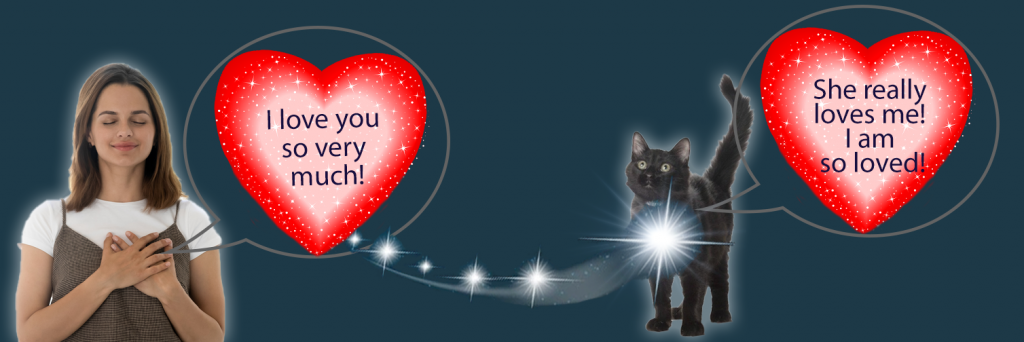
A. Close your eyes, take a nice deep breath and relax. Place your hands over your heart, and consciously enter the place in your heart where you feel love for your animal. Feel it so much that you smile and feel peace.
B. Picture all that love you feel for them traveling from your heart to theirs. It’s important to visualize it reaching them, not just holding it inside your own heart. You may want to picture it flowing as a certain color that represents love to you, or a color that represents your relationship. You may want to picture your love surrounded by beautiful light as it travels and reaches your animal. Those specifics are not important, but it is important to see it moving from your heart and being offered to theirs.
C. As you visualize the feeling of your love reaching your animal, say the words, “I love you.” You might personalize your words of love with whatever phrases have meaning to you and may be used regularly in your relationship:
I love you with all of my heart and soul Fluffy
I love you my precious little lion
I love you the best horse in the world ever born
I love you forever and ever my baby girl
Step 2:
Picture the specific behavior you want from your animal and send that picture to them (this can be a static picture or a video). Send a feeling of gratitude and say thank you for doing this.
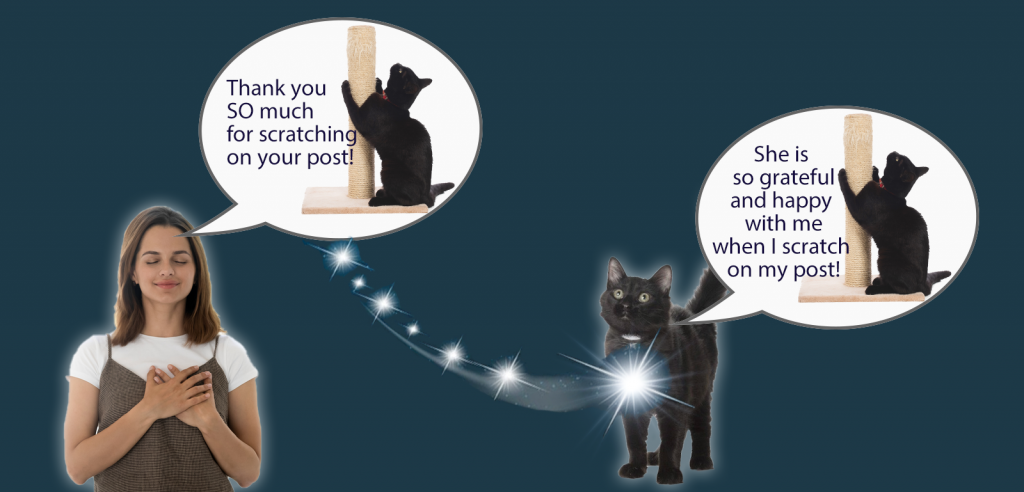
Hold a very clear picture in your mind of the specific behavior you WANT your animal to begin to do or continue to do. Picture your animal doing this specific thing in your mind, then send this picture from your mind to theirs.
See the picture traveling from your mind to your animal. As you visualize your picture reaching them, say thank you in whatever words are relevant to the situation and your relationship:
Thank you! I so appreciate you doing this!
Thank you so much for going in the litter box. It means a lot to me.
Thank you for coming in at dusk so I know you are safe.
It makes me so grateful for you to do this.
It makes me so happy to have you do this, thank you.
I so appreciate you making this change for me.
You might be picturing your cat using the litter box or a scratching post, your horse getting in the trailer with ease, your dog coming when you call or your puppy learning to eliminate outside only. Whatever the problem is that you’ve been dealing with, it’s important to picture WHAT YOU WANT, not what you don’t want. Clarification of what you don’t want and why should be part of a longer, separate conversation.
Be careful to picture it and comment on it as if it’s already happening:
Use: Thank you so much for doing this.
Don’t use: I WILL be so happy IF you do this.
You want to picturing it happening—not that it will hopefully happen—sending them a clear picture of what you want them to do and saying thank you. Doing this “as if it’s already happening” sends the message to our animals that not only is this a behavior we desire, but that we know they are capable of it.
Step 3:
Repeat Step 1—Tell them again how much you love them.

Feel the love you have for your animal, and picture your love traveling from your heart to theirs. Tell them you love them. As you picture this, send your animal abundant and gentle love from your heart. This “I love you” is separate from the visualized behavior. As with sending love in step one, it sends the assuring message to your animal that YOU LOVE THEM, separate from the behavior expected—that your loving them is not dependent on their behavior.
Important Guidelines & Considerations in Using This Technique
Frequency
Use everyday, once or twice each day, until the desired behavior has become the norm or at least significantly improved.
When to use and when not to use
Do not use this technique when you are right in the moment of being angry with, upset with or stressed out about your animal’s behavior—whether you have just witnessed the undesired behavior or its results, or are still upset thinking about it. This may sound counter intuitive, since when they urinate on the floor, just knocked over the kitchen waste can and started eating garbage or just scratched your new sofa, we naturally want to correct their behavior on the spot. And we should. We may sigh or cry in frustration, yell out “NO” in a loud voice, or give our animal a time out immediately after the undesired behavior. These reactions are NOT mutually exclusive to using this technique—but use it later when you are calm. This technique is not effective if used in the moments when we are upset. Why? Because we cannot fake a positive emotion when what we’re really feeling is a negative emotion, nor should we try. It’s simply too challenging and it’s not authentic communication. It’s very hard for most of us to muster up feeling calm enough to easily send positive loving thoughts when we’re angry or upset. And that’s OK. The technique can be used later, when we are calm.
Do not use this technique when you are upset or stressed about issues in your own life, unrelated to your animal. For all the same reasons that it’s not effective to use this technique in the moments of being upset with your animal, it is also not effective to use in the moments when you are feeling stressed about any issue in your life. While you do not need to be in a meditative state to use this technique, it is important that you do it at a time when you are not highly stressed, anxious or deeply preoccupied with any troubling thoughts. Wait to use it at a time when you can reasonably be relatively calm for the 15 seconds it takes to use the technique. (If you meditate, including this technique to communicate with your animal during that time would be very effective. But remember, you don’t have to be in a meditative state for this technique to work.)
Use just a few words
When using this technique just send the picture, the positive feelings, and a few very brief phrases (i.e., I love you so much, thank you so much). If you start sending too many words, it might get muddled. It is, of course, appropriate to use a lot of words at other times—longer conversations about the behavior problem are highly recommended to determine and understand the root causes of the problem behavior from the animal’s perspective and to explain in detail to our animals our concerns about the behavior and why it’s unacceptable. But those longer conversations, as important as they are, need to be separate from using this technique. There is something powerful about the simplicity of repetitive pictures with love and gratitude being sent. Imagine how lovely it might be for you to have someone who loves you send you a picture of you doing something “positive” and sending great love and your thank you with that picture—every day or twice a day!
PICTURE WHAT YOU WANT, not what you don’t want
Be very careful to picture WHAT YOU WANT, not what you don’t want. Again, the discussion and clarification of what you don’t want and why should be part of a longer, separate conversation. This technique is exclusively about clarifying and reinforcing what you DO want. The reason for this is that animals will pick up on the images in your mind very easily. If you’re picturing what you don’t want along with “I love you” and “Thank you” they may get confused and think that the undesirable behavior is what you do want.
This technique can also be used for behaviors we prefer from our animals, behavior we enjoy.
You don’t have to limit use of the technique for problematic behavior. For instance, perhaps you would love your cat to sleep closer to you on your bed, you wish your bird would sing more when you’re together, or you wish your dog would cuddle close to you on the couch instead of lying at your feet. These and similar issues are ideal ones for which to use this technique.
In Summary
Use the following three simple steps for about 15 seconds, once or twice a day, until the issue is considerably improved or resolved:
Step 1.
• Feel the love you have for your animal.
• Picture your love traveling from your heart to theirs.
• Tell them you love them.
Step 2.
• Picture the specific behavior you want from your animal and send that picture to them.
• Send your feeling of gratitude and say thank you for doing this.
Step 3.
• Feel the love you have for your animal again.
• Picture your love traveling from your heart to theirs.
• Tell them again how you love them.
As with all forms of communication, using this technique will not guarantee that your animal will do what you want just because you’ve shown them and told them what you want. However, it will yield much more positive change than only yelling, threatening, crying, ignoring or feeling helpless about the behavior—which are understandable responses when we’re exasperated with a behavior problem! It can also create deepened intimacy in our relationship because of the repeated act of sending love and gratitude every day.
Many of my clients have had great success using this technique, reporting both improved and changed behavior and a greater sense of closeness with their animals. I encourage you to use it and hope it will bring deepened understanding and intimacy between you and your animal loved one and at least one step—if not many steps!—closer to resolving behavior conflicts.

Further Resources:
On Demand Teleclasses (MP3 audio and PDF handouts):
How To Communicate with Animals—Introduction to Telepathic Animal Communication
How Animal Communication Can Help in Times of Illness, Hospice, Grief and After Death
Guided Meditations (MP3 audio format):
Animal Communication: Guided Meditation to Begin an Animal Communication Connection and Discussion about Energetic Preparation
Connecting with The Soul of Your Animal After Death
Consultations:
Animal Communication Counseling Consultations with Teresa
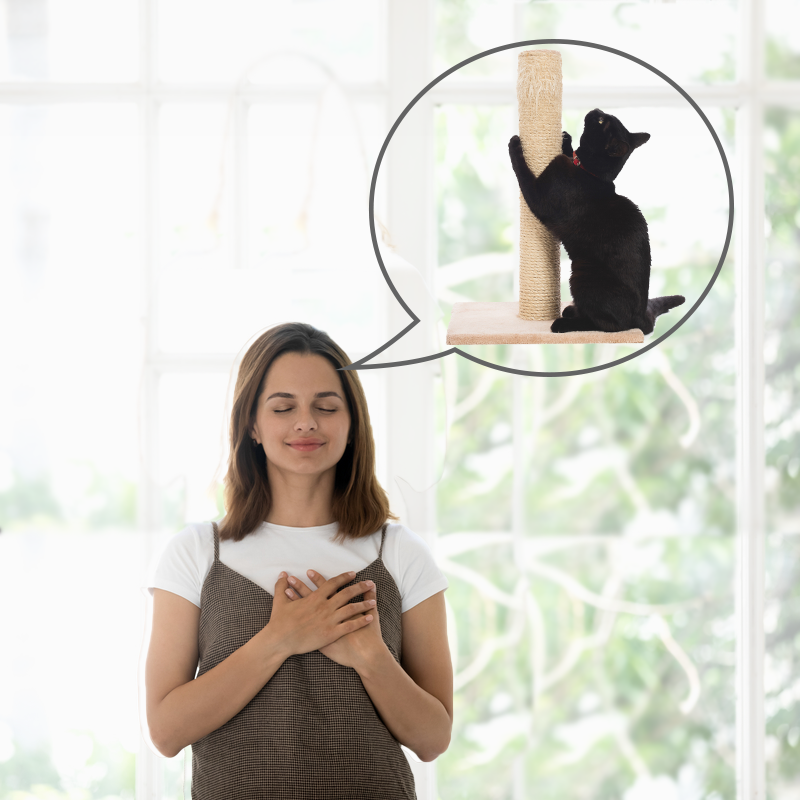
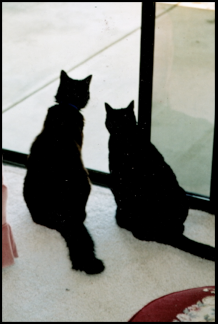

 Thank you for visiting my blog. It is a place for me to share stories from and about animals, love, loss and healing. The articles are primarily written by me, but some are from my colleagues who have graciously allowed me to share their words here.
Thank you for visiting my blog. It is a place for me to share stories from and about animals, love, loss and healing. The articles are primarily written by me, but some are from my colleagues who have graciously allowed me to share their words here. 

